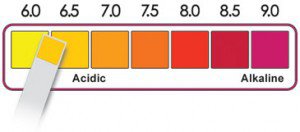With thanks to Dr Ben Kim
Is it true that the foods and drink you consume cause your blood to become more alkaline or acidic?

Contrary to popular hype, the answer is: not to any significant degree.
The pH of your blood is tightly regulated by a complex system of buffers that are continuously at work to maintain a range of 7.35 to 7.45, which is slightly more alkaline than pure water.
If the pH of your blood falls below 7.35, the result is a condition called acidosis, a state that leads to central nervous system depression.
Severe acidosis – where blood pH falls below 7.00 – can lead to a coma and even death.
Alternatively, when the pH level of the blood increases beyond 7.45, it leads to a condition called alkalosis. This can be fatal, albeit through a distinct mechanism.
Alkalosis can make all the nerves in the body hyper-sensitive and over-excitable, which may result in muscle spasms, nervousness, and convulsions. In severe cases, it is the convulsions that can cause death.
It's important to understand that as long as you're breathing and carrying out your daily routine, your body is effectively maintaining a blood pH level between 7.35 to 7.45.
Ergo, the foods you consume aren't causing any significant fluctuations in your blood pH.
So.. what's the buzz surrounding the importance of alkalizing one's body? Is there any truth to the assertion that excessive acidity can lead to undesirable health issues like osteoporosis and kidney stones?
To answer any questions about human health, it's important to understand the basic principles of human physiology. Let's explore the fundamentals of pH and how the body maintains the balance of acid and alkaline in its fluids constantly.
pH is a measure of how acidic or alkaline a liquid is.
Now let’s look at the fluids in your body.
When it comes to your health, your body fluids can be divided into two main categories: intracellular and extracellular fluid.
~Intracellular fluid, also known as cytosol, can be found in all of your cells and makes up approximately two-thirds of the total amount of fluid in your body.
~ Extracellular fluid is located outside of your cells and can be classified into two types:
~ Plasma, which is the fluid that makes up your blood,
~ and interstitial fluid, which occupies the spaces surrounding your tissues. It is a water solvent containing sugars, salts, fatty acids, amino acids, coenzymes, hormones, neurotransmitters, white blood cells and cell waste-products. This solution accounts for 26% of the water in the human body. It is slightly alkaline, and saline.
Interstitial fluid comprises fluids present in various parts of the body such as the eyes, lymphatic system, joints, nervous system, and between the protective membranes surrounding the cardiovascular, respiratory, and abdominal cavities.
Your blood (plasma) needs to maintain a pH of 7.35 to 7.45 for your cells to function properly. The most important reason your cells require your blood to maintain a pH in this range to stay healthy is that all of the proteins that work in your body have to maintain a specific geometric shape to function, and the three-dimensional shapes of the proteins in your body are affected by the tiniest changes in the pH of your body fluids.
The pH scale ranges from 0 to 14, with a pH of 7 being considered neutral. Pure water is an example of a substance with a neutral pH. Liquids with a pH below 7, such as lemon juice and coffee, are considered acidic, while those with a pH above 7, like human blood and milk of magnesia, are considered alkaline.
Please keep in mind that the pH scale is logarithmic, meaning that each number represents a tenfold difference from the adjacent number. For instance, a liquid with a pH level of 6 is ten times more acidic than a liquid with a pH level of 7, while a liquid with a pH level of 5 is one hundred times more acidic than pure water.
Carbonated soft drinks usually have a pH level of about 3, making them ten thousand times more acidic than pure water.
When consuming food and beverages, the process of digestion and nutrient assimilation can lead to the formation of acid or alkaline end products, commonly referred to as acid ash or alkaline ash.
As your cells constantly produce energy, various acids are created and released into your body fluids. These acids are a result of your normal metabolic processes and cannot be avoided. Your body will constantly produce acids as long as it needs to generate energy to survive.
On a daily basis, there are two primary factors that can disturb the pH of your body fluids – the acidic or alkaline effects of the foods and liquids you consume, and the acids produced through your regular metabolic processes. However, your body has three significant mechanisms consistently working to maintain the pH of your blood within the range of 7.35 to 7.45.
These factors are:
- Buffer Systems
Carbonic Acid-Bicarbonate Buffer System
Protein Buffer System
Phosphate Buffer System - Exhalation of Carbon Dioxide
- Elimination of Hydrogen Ions via Kidneys
These systems are in place to prevent dietary, metabolic, and other factors from pushing the pH of your blood outside of the 7.35 to 7.45 range.
Many internet vendors suggest "alkalizing your blood," which essentially means incorporating more alkaline-forming foods into your diet. This recommendation stems from the fact that most heavily processed foods, such as white flour products and white sugar, have an acid-forming effect on the body. Consuming a diet that is primarily acid-forming for years can overtax certain buffering systems mentioned earlier, leading to potential negative impacts on your overall health.
A fascinating fact is that the phosphate buffer system in your body utilizes various phosphate ions to balance out strong acids and bases. Most of these phosphate ions, around 85%, come from calcium phosphate salts that make up the structure of your teeth and bones. However, when your body is frequently exposed to acid-forming foods and drinks, it will deplete its calcium phosphate reserves to fuel your phosphate buffer system and counteract the acid-forming effects. This can eventually lead to a weakening of your bones and teeth.
When your body uses up its calcium phosphate reserves quickly, it can result in a higher elimination of calcium through your genito-urinary system. This is why a diet that is mostly acid-forming can lead to a greater chance of developing kidney stones that are rich in calcium.
One instance of overloading your buffering systems can lead to adverse health effects. Your buffering systems are in constant operation to counteract the acids produced from daily metabolic functions. Therefore, it's advisable to adhere to a diet that doesn't overburden your buffering systems with unnecessary work..
Acid and Alkaline-Forming Effects of Foods
Generally speaking, most vegetables and fruits have an alkaline-forming effect on your body fluids.
Most grains, animal foods, and highly processed foods have an acid-forming effect on your body fluids.
For optimal health, it's important to have a balanced intake of nutrient-rich foods that contain both alkaline and acid-forming properties. It's recommended to consume more alkaline-forming foods than acid-forming ones to maintain a slightly alkaline pH in your blood, which promotes overall well-being.
The following lists indicate which common foods have an alkaline-forming effect on your body fluids, and which ones result in acid ash formation when they are digested and assimilated into your system.
Foods with a moderate to strong alkaline-forming effect
Watermelon
Lemons
Cantaloupe
Celery
Limes
Mango
Honeydew
Papaya
Parsley
Seaweed
Sweet, seedless grapes
Watercress
Asparagus
Kiwi
Pears
Pineapple
Raisins
Vegetable juices
Apples
Apricots
Alfalfa sprouts
Avocados
Bananas
Garlic
Ginger
Peaches
Nectarines
Grapefruit
Oranges
Most herbs
Peas
Lettuce
Broccoli
Cauliflower
Foods with a moderate to strong acid-forming effect
Alcohol
Soft drinks (pop)
Tobacco
Coffee
White sugar
Refined Salt
Artificial sweeteners
Antibiotics (and most drugs)
White flour products (including pasta)
Seafood
White vinegar
Barley
Most boxed cereals
Cheese
Most beans
Flesh meats
Most types of bread
This list isn’t complete. To access the best and most scientifically based list of acid and alkaline foods, we recommend D. Susan Brown’s excellent book here.
If you consume a diet that primarily consists of grains, flour-based products, animal-based foods, and beverages such as coffee, soda, and milk, making a conscious effort to incorporate fresh fruits and vegetables into your meals can greatly enhance your overall health.
In this article, we aim to provide valuable information that supports our fundamental experience that consuming nutritional supplements or "alkalized water" solely for the purpose of alkalizing your body is unnecessary. Your body has a natural ability to maintain the pH level of its fluids within a narrow, slightly alkaline range.
However, this free report on over 100 scientific studies of the effect of alkaline water on general health and wellbeing is well worth a read.
A healthy eating plan involves making fresh vegetables and fruits the focal point of your meals. You can also include small portions of other nutrient-rich foods that your body can handle and that you crave.



